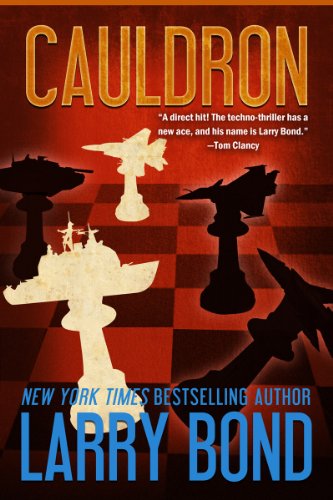
I first read Cauldron in high school, and at the time, I remember that it didn’t make as much of an impact on me as Red Storm Rising, Red Phoenix, or even Vortex did. A new war in Central Europe seemed somewhat more far-fetched at the time than chaos in Africa or East Asia. (I was in high school; I didn’t know nearly as much as I might have thought that I did.)
But in prep for Maelstrom Rising, I picked Cauldron back up. And I’ve got to say, Larry Bond was a lot more prescient than he seemed, back in ’93.
While the general scenario in Cauldron is the French and Germans enforcing their economic hegemony over Eastern and Central Europe by force of arms, effectively forming the European Union at gunpoint (referred to as the European Confederation, or EurCon in the novel), the fault lines that lead to the scenario are even now playing out, only slightly differently.
In Cauldron, Eastern Europe is chafing under France’s thumb. In the aftermath of the end of the Cold War, they allowed much French industry in (particularly in Hungary), only to find that they got the scraps while the French built factories and staffed them with either Frenchmen, or North Africans when they wanted cheaper labor. The resulting economic downturn, coupled with a particularly harsh winter that threatens large portions of Europe with starvation, only makes matters worse when the French and Germans turn the screws on countries that want a more equal economic footing.
Of course, France and Germany are feeling the pinch, too, with the regular people getting the short end of the stick when “Arabs,” being the general pejorative for all North Africans and actual Arabs who were brought into France as cheap labor, get more of the jobs because they get paid less. Riots break out, and soon France and Germany are under martial law, as is Russia, for only slightly different reasons.
Refusing to let a crisis go to waste, the head of the DGSE, Nicholas Desaix, hatches a plan for the European Confederation, a solution to the crisis in Europe via centralized control, centralized, of course, in Paris and Berlin. Soon, countries that signed on to EurCon are finding their security forces being run by French and German officers, to their countrymen’s detriment.
Hungary revolts, setting the whole thing in motion. When the French move on Hungary, the Poles come to the Hungarian’s defense. At French instigation, Russia turns off the oil and natural gas to Poland, right in the middle of winter. When the Poles beg the US for assistance, the Americans get involved, even as German tanks begin rolling across the Polish frontier.
Sound familiar?
While this book came out in ’93, just before the formal formation of what we now know as the EU, the very fault lines described are currently fracturing the European Union. Arab and North African immigrants have turned entire sections of Paris into no-go zones, tribal ghettos within France. Regular Frenchmen are rioting, disgusted by the elites’ disdain for their lives and culture. And Eastern Europe is increasingly telling the EU to go piss up a rope; Poland and Hungary have both closed their borders to the immigrants that Paris and Berlin are demanding all European nations welcome with open arms.
Being a Larry Bond book, the focus is largely on large unit actions, with a lot of air and naval combat, with hundreds of pages spent on the political and economic machinations that led to the crisis. It’s still an excellent war story, painting a picture of a land war in Europe that seemed far from even the imagination when it was written.
Now, the next bit potentially involves spoilers (if you can spoil a book that’s been out for 26 years)
My only real beef is the ending. Granted, it was a mid-’90s techno-thriller, and there were certain conventions even to the major war subgenre at the time. Everything had to return essentially to the status quo ante at the end, though with governments taking steps to foster cooperation and make sure that it didn’t happen again. Cauldron is no different. What struck me was the plan at the ending involves the President essentially proposing a new League of Nations/United Nations, to “make sure this doesn’t happen again.” The President has been depicted as generally level-headed the entire book, and yet, at the end, his proposal simply amounts to “Let’s do the same thing that’s been tried after the last two major wars, that didn’t work then.”
Overall, though, Cauldron is very much up to the standard that Larry Bond set with Red Phoenix and Vortex. And is surprisingly spot-on in its predictions, even if they seemed far-fetched when it was written.